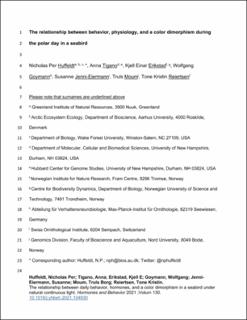| dc.description.abstract | The predictable oscillation between the light of day and the dark of night across the diel cycle is a powerful selective force that has resulted in anticipatory mechanisms in nearly all taxa. At polar latitude, however, this oscillation becomes highly attenuated during the continuous light of polar day during summer. A general understanding of how animals keep time under these conditions is poorly understood. We tested the hypothesis that the common murre (a seabird, Uria aalge) can use melatonin and corticosterone, hormones associated with timekeeping, to track the diel cycle despite continuous light. We also tested the assumption that common murres breeding during polar summer schedule their colony attendance by time of day and sex, as they do at subpolar latitude. In the Atlantic population, common murres have a plumage color dimorphism associated with fitnessrelated traits, and we investigated the relationship of this dimorphism with colony attendance, melatonin, and corticosterone. The common murres did not schedule their attendance behavior by time of day or sex, yet they had higher concentrations of melatonin and, to a more limited extent, corticosterone during “night” than “day”. Melatonin also linked to behavioral state. The two color morphs tended to have different colony-attendance behavior and melatonin concentrations, lending support for balancing selection maintaining the plumage dimorphism. In common murres, melatonin can signal time of day despite continuous light, and the limited diel variation of corticosterone contributes to the mounting evidence that polar-adapted birds and mammals require little or no diel variation in circulating glucocorticoids during polar day. Arctic Circadian rhythm Color dimorphism Continuous light Corticosterone profile Daily rhythm Glucocorticoid profile Melatonin profile Midnight sun Uria aalge | en_US |

